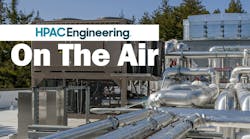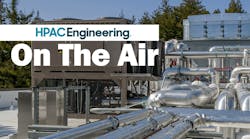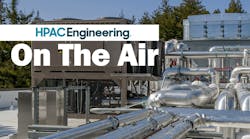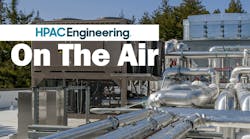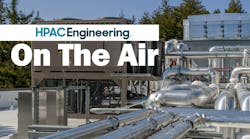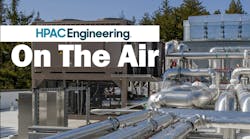"Big changes are coming! Big changes are coming!"
This month, as we enter an already steamy summer, our subject appropriately enough is refrigerants. Quite a bit is actually happening in that area, so HPAC Engineering reached out to Jim Cika, director of PMG technical resources for the International Code Council (ICC).
There, Cika serves as a subject matter expert on plumbing, mechanical, fuel gas and swimming pool and spa codes. He represents ICC in federal and state coalitions, task forces, committees, and councils where expertise in I-Code subjects is needed.
- To view Cika's January summary on refrigerants for ICC's Building Safety Journal, click here.
With more than 20 years of industry experience in manufacturing and construction, including time as an HVAC design engineer, Cika holds a mechanical engineering degree from the Georgia Institute of Technology. Here, he previews major code changes upcoming on A2L refrigerants that will impact our industry much sooner than many may realize. So soon, in fact, that ongoing global supply chain delays had best be figured in to building managers' decision-making, he says.
Click below to listen to the interview...
############
EDITED TRANSCRIPT
HPAC: Mr. Cika, thanks so much for joining us on HPAC On The Air. There seems to be quite a bit going on with the International Code Council this year. Before we get to some specifics, can you first describe your role with ICC and your background a bit?
Jim Cika: Thank you for this opportunity. I have been in this role as director of PMG technical resources for more than five years now. I do have a mechanical engineering degree from Georgia Tech, and I did start my career as an HVAC design consultant. But from there, I shifted my focus to appliance manufacturing, where over a period of about 20 years, I served as a chief engineer responsible for regulatory and product standards, building codes and product engineering matters for manufacturers of water heating and space heating appliances.
So, as many of your readers and listeners may know, the energy efficiency of products from those sectors is regulated from the U.S. Dept. of Energy. What they may not know is that the U.S. Environmental Protection Agency (EPA) regulates many of the materials and chemicals, including refrigerants, used in the manufacturing of those products. So I have spent a lot of time and energy over the last 20 years helping the companies that I worked with, and their customers, to prepare for and plan for, changes in the federal regulations imposed by these agencies. Many of my experiences from the past are similar to what the HVAC&R industry is going through today, in regards to refrigerants.
HPAC: Very good. Let's dive right into some of those specifics on refrigerants. Last year, EPA issued a new rule under the American Innovation and Manufacturing Act of 2020 that will mandate an 85% phasedown in HFC refrigerants over the next 15 years. Already, more sustainable A2L refrigerants are starting to be ushered in to take their place and codes are being changed accordingly. You wrote on this subject for ICC earlier this year. Can you give us an update on related code change proposals that reflect those new refrigerant standards?
Cika: Sure thing. Before I get into the code changes, let's first look at the EPA regulations. Back in the 1990s, EPA initiated the phaseout of the CFC and HCFC refrigerants, due to the breakdown of the ozone layer. So, CFCs and HCFCs were replaced with hydrofluorocarbon refrigerants, or the HFCs that we're currently using. Those have an ozone-depletion potential of zero, and at the time, they were a good fit to fill the void left by the elimination of the CFCs and HCFCs. However, they are also potent greenhouse gases with a medium-to-high global warming potential (GWP), which can cause long-term harm to the environment.
This brings us to the EPA's latest rules, which as you noted, will mandate that 85% phasedown in both the production and the consumption of HFC refrigerants over the next 15 years. Now, just as the HFCs filled the void left by the phasedown of the CFCs and HCFCs, the latest phasedown has ramped up acceptance of the other class of refrigerants to fill the new void. Last year, EPA adopted a final rule accepting six refrigerant alternatives for use in new residential and light commercial air conditioners and heat pumps that meet the requirements in UL 60335-2-40 (Edition 3) for air-conditioning equipment. Each lower GWP alternative — R–32, R–452B, R–454A, R–454B, R–454C and R–457A — is classified by ASHRAE as A2L, for mildly flammable.
A2L refrigerants have lower toxicity and flammability than A2 or A3 refrigerants. A1 refrigerants have no flammability. As of December 2018, more than 68 million air conditioners using A2L refrigerants have been installed around the world and have been used safely.
However, A2Ls for use in residential and light commercial are new to the U.S. These replacement refrigerants have different flammability characteristics, so safety, training, and in particular, building codes all had to be addressed. The 2021 and earlier versions of the building codes don't allow A2L refrigerants to be used for human comfort, meaning for air-conditioning in homes and businesses. There were concerns about the flammability of those refrigerants that had impacted their acceptance within the codes.
On the standards side, however, safety standards for air-conditioning systems, such as ASHRAE 15, UL 484, and others, were all updated and now include coverage for A2L refrigerants. With these standards now in place, and the flammability concerns being resolved through some recent analysis by AHRI (Air Conditioning, Heating, and Refrigeration Institute) and some testing performed by UL, the 2024 International Building Codes were recently updated to include A2Ls. So, changes have been made now to the building, fire and mechanical codes, making them consistent with the ASHRAE, UL, and other standards addressing the A2Ls. So, with these changes, the 2024 IBC, IFC, and IMC all will permit the use of A2L refrigerants for human comfort use, consistent with industry standards. That will help to facilitate the phase-down of HFCs, following the EPA rules.
These changes are extremely important, as the EPA phasedown mandates a 40% reduction in the production of HFCs, beginning in January 2024.
HPAC: Of course, that is just the end of next year. So with these changes fast-approaching, how can HVACR professionals best prepare for them? What should they be doing to get ready?
Cika: Well, that's a multi-faceted question. Looking first at the key code changes to the 2024 Mechanical Code, the code is going to require "Risk of Fire" labels for A2L piping, due to its flammability. You'll see requirements for building shafts that contain A2L piping, including requirements for continuous ventilation, and requirements for leak detection within the shafts. Looking at the machinery rooms housing A2L refrigerant, they cannot contain flame-producing equipment, or equipment with continuously hot surfaces above 1290°F. Machinery rooms also will require refrigerant detectors that signal an alarm and activate the room's ventilation system, complying with the ASHRAE 15 Standard.
In addition to these, the code also will limit the amount of A2L Refrigerant that can be used within an air-conditioning system used for human comfort. Residential systems will have a limited maximum capacity of 6.6 lbs. of refrigerant, and commercial systems will have a limit of up to 22 lbs. of refrigerant.
So, those are the most important changes that need to be addressed. And that can be easily done through the design process, by HVAC engineers, and such. Where things get tricky is when you're planning for the future, because it comes with that EPA 40% phase-down requirement for 2024. So, by January 2024, we have to be 40% lower than where we are. That's only 18 months away!
So, at a minimum, we need to look at adoption of the 2024 codes that do permit the A2L refrigerants for comfort conditioning. Another thing we need to look at is the supply chain for the availability of air-conditioning systems that utilize A2L refrigerants. And lastly, we need to look at the contractor network, for installation and for servicing.
But looking at code adoption, right now the majority of U.S. jurisdictions have adopted the 2012, 2015, 2018, or 2021 codes. But the 2024 codes aren't even available for adoption yet. So, the Code Council right now is working with state and local jurisdictions to get them ready for 2024. With the federal mandate, for this transition to go smoothly, it's going to be absolutely necessary for them to have measures in place to allow the use of A2L refrigerants, beginning in 2024.
HPAC: Supply chain issues are certainly in the news this year so far. Please speak a bit more about how that is creating such a squeeze in this refrigerant market.
Cika: When we look at the supply chain and the manufacturers, you have to understand that due to the flammable nature of A2L refrigerants, you can't just convert equipment that uses HFCs to those that use A2Ls. And as with the previous EPA phasedowns going back to the 1990s, much of the refrigerant that is going to be produced at that time (2024) is still going to be needed for maintenance of existing equipment that's already out there in the marketplace. So, what that means is that manufacturers have essentially just one and half years now to transition their manufacturing process to produce the new equipment that utilizes the A2L refrigerants. And they will also need to fill the supply chain with that product ahead of 2024.
Much of this is already being addressed by AHRI and other groups that represent the manufacturers. So, a lot of work has been done going down that road already. But there is still a lot of concern now about whether or not we're really going to be ready for that transition to take place. Also, what will the implications of that 40% reduction be for those refrigerants that are already in the supply chain. Stuff like that.
When we look at the contractors, both the installers as well as the service firms, there's a whole, completely different set of issues to address. For instance, contractors need to confirm that the tools and instruments they use today are compatible with the A2L refrigerants. Will standard hand tools and wrenches be the same? They'll need to verify that vacuum pumps, leak detectors, and their refrigerant recovery equipment is also going to be compatible. They may find that what they're currently using today may not be suitable come January 1. So, you've got a whole 'nother supply chain issue over whether or not there is going to be enough of that new equipment and tools out there, come 2024.
They're also going to need to review and understand the new requirements and procedures related to the handling and use of the A2Ls. So there's a whole 'nother set of requirements for them to know. There's a lot to look at and I know AHRI is doing a lot of work on trying to get training out there. At the Code Council, we're also looking to develop some training to help prepare for that.
HPAC: You had mentioned before that there would be benefits to being an early adopter of the new code. But if it is technically not yet even available, then how can firms get out ahead of this to be early?
Cika: Well, that's kind of the conundrum that we're in. Because of the regulation that is in place at the federal level, it is incumbent upon us to work with our membership and local jurisdictions to make sure that there is something in place so that we are not a hurdle. Codes can't be a hurdle to that requirement. It's going to have to happen, so we need to find a way to do that. We're at the very early stages of this. We just finalized the 2024 Code, so now we are going to go back and look at jurisdictions that might be on, say, the 2012 Code. We want to see what would be required for them to amend their existing codes to be in compliance with the new 2024 Code.
Looking at the benefits of being an early adopter? Well, here, when it comes to manufacturers, contractors and distributors, I would say that for them, their biggest benefit is that they're going to survive this transition. And survival is a very important thing to look at here. Come January 2024, you are going to need to have things in place that allow you to continue to do business as usual. Unlike with the previous phase-out, this does require new equipment. Wholesale distributors have to look at new storage requirements. And because of the flammability of the A2Ls, the requirements are different from what they were for non-flammables. Before, they could carry an unlimited supply in their warehouse. Now it's limited by code how much can be in a certain room, etc. So they have to take these things into consideration... and planning needs to start now.
HPAC: Since time is of the essence, where can our readers go to find out more information about what they need to do and by when, regarding these new refrigerants?
Cika: Well, on the code side of things, I would go to https://www.iccsafe.org/pmg/ and look for our related resources on this subject that we will be posting. We have four other PMG directors, like myself, who all cover different regions of the country, and we are all accessible through that website. So, your readers should feel free to contact us if they have any questions.
############
To listen to previous 'HPAC On The Air' podcasts, visit our Members Only page.


